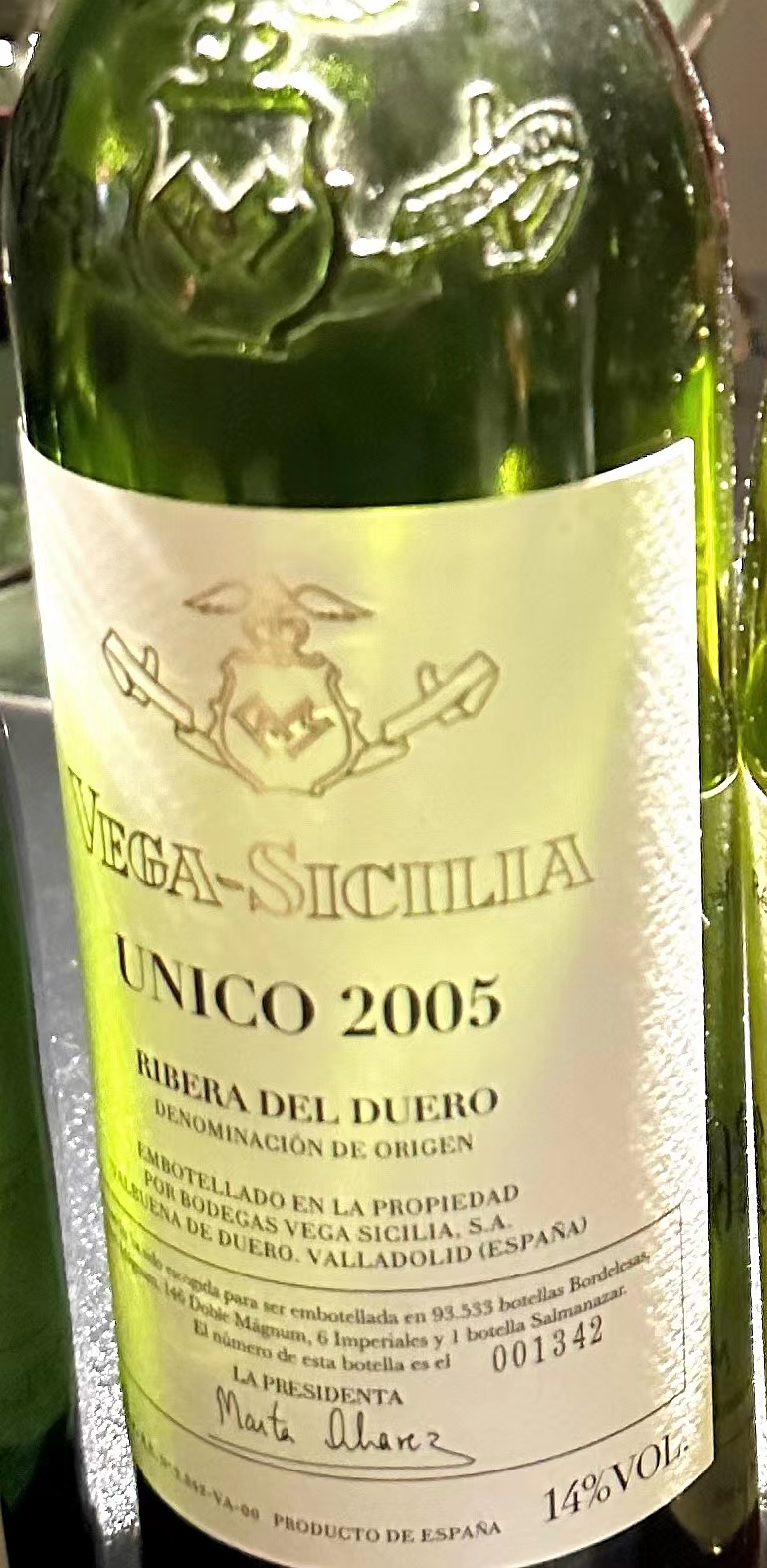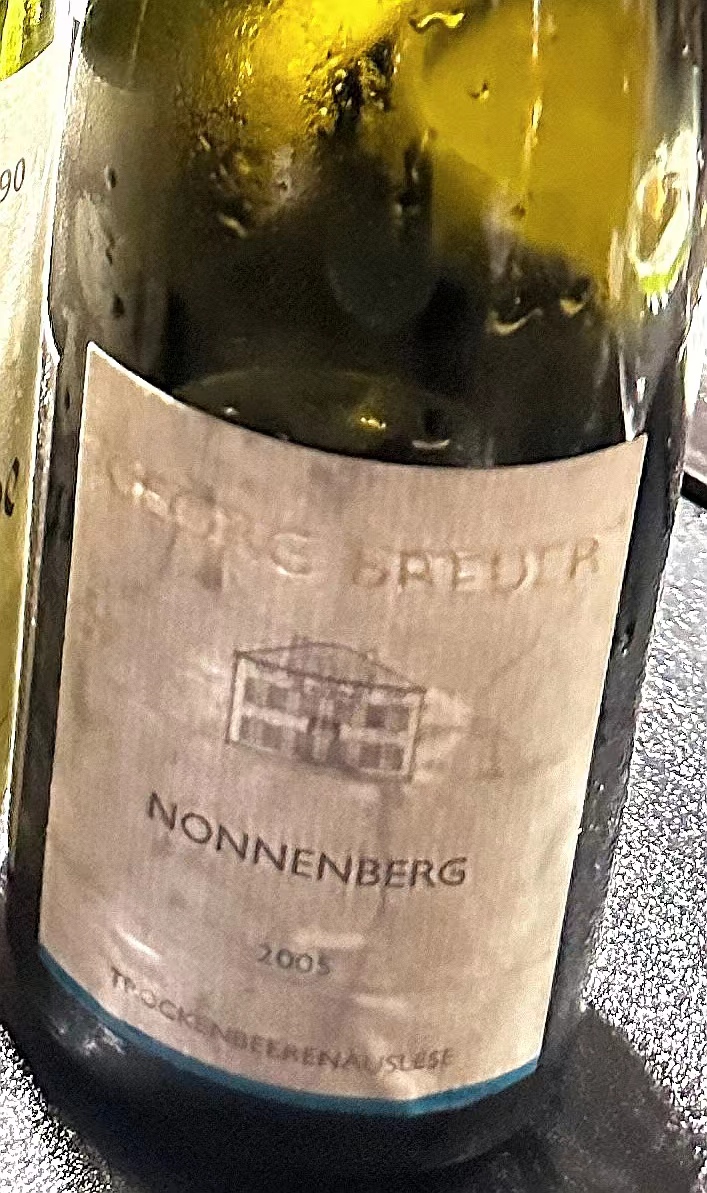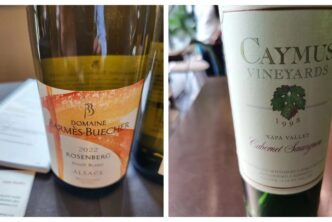Vega Sicilia 2005 Unico Rioja 96

Bright rich red-ruby with a garnet rim. Ripe red cherry and plum, blackberry, smoke, sweet pipe tobacco, vanilla, and spices on the forward, inviting nose. Then also quite forward in the mouth (certainly more than another bottle of the same wine I had last year) but at once dense and light on its feet with the creamy spice and red fruit flavours lingering long on the suavback end, nicely framed by harmonious acidity. Very polished and smooth, boasting plenty of energy and focus even at almost twenty years oif age. This specific bottle showcased great finesse but less power than some others I have had of this wine or of the 2006 Unico for example, but the 2005 is, without doubt, one of the most balanced and easiest to drink Vega Sicilia Unicos of the last twenty years. A blend of 94% Tempranillo and 6% Cabernet Sauvignon planted on colluviums deposit soils with limestone fragments and quartz-gravel sand and boulders below, this was aged one and a half years in new oak, another year in used barrels (of both French and American oak), and finally then roughly two and a half years more in 20,000 liters large-format tanks. About 95,000 bottles made, which is remarkably impressive given this wine’s quality, and less than 5,000 various large formats. Drinking window: 2024-2031.
Vega Sicilia’s Unico is one of the world’s most famous red wines (the “unico” name is not the usual wishful thinking exaggeration of a winery, but is actually well-deserved, in this case). The 2005 vintage was marked by a dry winter, a dry spring, a hot summer but a very fine autumn season, and was characterized by generally early growing season parameters. All of which is pertinent, in that the 2005 Unico is an especially interesting Unico; just like the 2006, it was born powerful and structured, requiring even more time than usual in the bottle (two more years, in fact; it was released after both the 2006 and 2007 Unicos) to be ready to show all its considerable charms and merits. This bottle I describe here seemed to be even readier to drink than I would have expected, but was just splendid.
Georg Breuer 2005 Nonnenberg Riesling Trockenbeerenauslese 93

Georg Breuer is one of Germany’s top wine producers. Founded in 1880 by the Hillebrand and Scholl families as a wine merchant company (négociant), it was purchased by Peter Breuer in the early twentieth century and has remained in the hands of the Breuer family ever since. The estate takes its name from Peter’s son Georg who renamed the winery, increased its vineyard holdings and began exporting his wines. Georg’s sons Bernhard and Heinrich took over, and this coincided with the rise to international prominence of the winery thanks to Bernhard’s incessant travel and initiatives (such as founding the Charta Rheingau in 1994, which later merged with the VDP Rheingau in 1999). After the sudden, unexpected death of Bernhard, his daughter Theresa (along with longtime production manager Hermann Schmoranz) took over and the winery has continued to rank among Germany’s wine quality leaders. Today the winery has roughly forty hectares in some of the best sites of the Rheingau [in Rüdesheim (25,5 ha); Rauenthal (6,5 ha); and Lorch (8 ha), 65% of which are of steep slopes planted to 86% Riesling, 10% Pinot Noir, 3% Pinot Gris, 1% Pinot Blanc, and even the very rare local Orléans and Heunisch].Vineyards are farmed by certified organic methods, yields are low and the estate’s wines are mostly of the dry kind; this is fashion nowadays (and often ill-advised, given some of the truly disappointing, no fun to drink wines made in Germany today even at the highest levels of quality such as the GGs), but at Breuer this has always been a way of laife, and not at all a sorry chasing of fads or a desire to be unbearably trendy. Clearly, they make late harvest wines when the conditions allow, but it’s the classically dry wines that rule the roost at this address.
musky and feral in its twisted florality, and that goes double for this vineyard-designated offering. Nose-wrinkling narcissus and faded iris share aromatic billing with pungent lemon and lime rinds as well as with peat, kelp, sea breeze and wet stone. There is an almost charred, carboniferous mid-palate aspect that adds to the complexity and intrigue of a low-toned, darkly herbaceous and mineral personality, with citrus pip piquancy and sheer density underscoring the wine’s sense of grip. But at the same time, juicy citrus serves for its special sense of brightness, leading to animation and refreshment that carry into the seriously-persistent as well as mouthwateringly salt-tinged finish that already drinks stunningly well. Already the second wine of the cru, the 2018 Rauenthal Estate Riesling is a stunner and highly recommended when you want to have a lot of terroir expression for a moderate price. Top Rauenthalers have the mysteries of great Nahe Rieslings, and we’d know this better if there were only more top Rauenthalers (this commune is ground-zero for Rheingau underachieving,
Bright pale golden yellow color. Very fresh and still young nose of lime, lemon and jasmine, but also much riper yellow fruit notes (peach, banana) typical of hot vintages (which 2005 certainly was) complicated by notes of acacia honey and obvious elements or-dried grapes with spicy botrytis in the background. Creamy but lifted in the mouth, with juicy flavours of peach, lemon custard, puff pastry, aromatic herbs and acacia honey. At once airy and rich, this has just enough acidity to avoid the sweetness from becoming cloying. Not the most concentrated TBA you’ll ever drink, but boasts noteworthy elegance on the chalky, saline and very citrussy finish that is fresh and long. The Nonnenberg of Rauenthal is a Georg Breuer monopole, named after the nuns of the Abbey Tiefenthal that cleared the forest centuries ago. It is about 5.4 hectares large characterized by a weathered phyllite slate, quartzite, loess and loam soil, faces south to southwest, and is located at an altitude of 110 to 180 metres above sea level with a nosebleed-inducing slope of 30 to 55%. It all adds up to wines of racy acidity but that are full-bodied and have enough power too. Drinking window: 2024-2030.

 中文
中文



